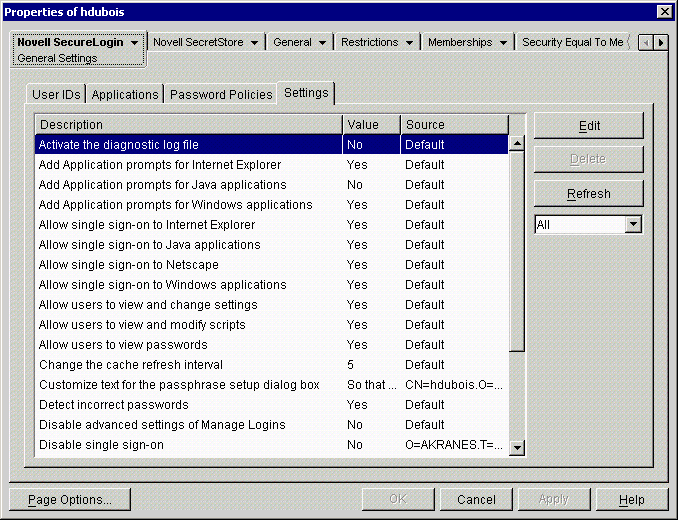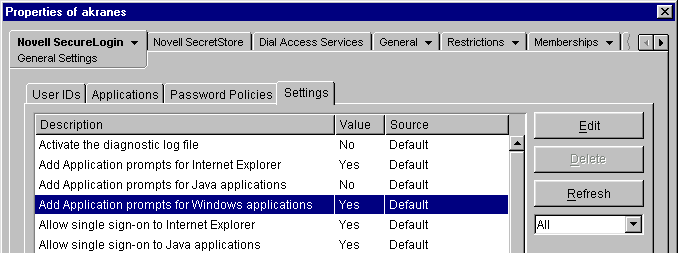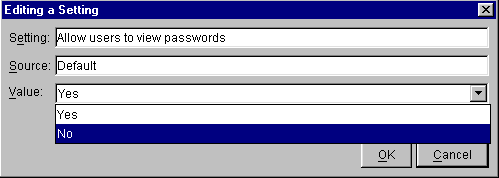Managing Administrative and User Settings
This section provides information on the following:
- Understanding the Configuration Hierarchy
- Viewing SecureLogin Settings
- Configuring SecureLogin Settings
Understanding the Configuration Hierarchy
You can apply SecureLogin settings to a Container object, a User object, or a workstation.
- Container object
Settings applied to a Container object affect all users and objects in and below that Container object.
- User object
Settings applied to a User object supersede the settings applied to a Container object or to a workstation.
- Workstation
You can give users the ability to apply settings to a workstation. However, any settings applied to a User object supersede settings applied to a workstation.
Viewing SecureLogin Settings
You can view SecureLogin settings by using SecureLogin on the desktop, ConsoleOne, Microsoft Management Console in Active Directory environments, or SecureLogin Manager.
-
Click Settings.

The Description column (Setting Description in MMC and on the desktop) explains a setting's purpose or action.
The Value column lists the default or changed value.
The Source column (Inherited From in MMC and on the desktop) displays the origin of the setting's value. The origin can be one of the following:
- A default value
- Manually configured at the User object level
- An inherited value
-
Scroll to the desired setting.
The following table provides information on the settings. If you are running in standalone mode, not all settings are displayed.
To access the Settings tab for Active Directory:
Configuring SecureLogin Settings

The Settings page enables you to control SecureLogin functionality. Users are able to view a subset of these settings. Depending on the values you set, users can change the subset of settings on their workstations. Local settings (subset) override user settings that you make.
You can't delete a setting. When you click Delete in SecureLogin or the snap-in to MMC, the setting changes to the default value.
Also, if SecureLogin can't enforce a policy, SecureLogin changes the specified value to a valid approximation. For example, if you set the minimum password length greater than the maximum password length, SecureLogin can't enforce that setting.
-
Click Settings.
-
Click a setting, click Edit, change the value by using the drop-down list, then click OK.
The following figure illustrates the Editing a Setting dialog box in ConsoleOne:

To customize text for the passphrase setup dialog box, type the text. The customized text replaces the default text.
-
Save changes by clicking OK or Apply.
Inherited fields in the SecureLogin Settings page don't apply until the corresponding settings are saved. To save inherited settings, click OK, close SecureLogin, then re-open SecureLogin.
Displaying the System Tray (Task Bar) Icon
When SecureLogin is installed, a Post-Install screen displays the following options:

If the Start SecureLogin on Windows Startup check box, SecureLogin places the SecureLogin icon on the task bar whenever the workstation is started.
To prevent users from displaying and accessing the task bar icon:
-
Using administrative tools, right-click the Container or User object, then click Properties > Novell SecureLogin > General Settings > Settings.
-
Select Display the System Tray Icon, then click Edit.
-
Using the drop-down list, change the value to No.
-
Save the changes by clicking OK twice.
If you turn off the SecureLogin icon on the task bar (workstation) and then use another tool to change the data, the changes won't take effect until the workstation is restarted.
Disabling the Local Cache
To use login data when you work offline, you can store login data in encrypted files on your workstation. By default, these cache files are located in the \documents and settings\profile\application data\securelogin\cache directory.
To disable the cache by using SecureLogin:
-
Right-click the SecureLogin icon on the task bar, select Advanced, then select Change Settings.
-
Select Settings > Enable Cache File.
-
Click Edit, set the value to No, then click OK twice.
To disable the cache by using administrative tools: